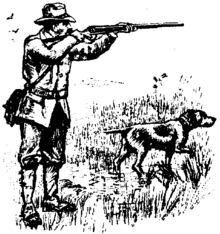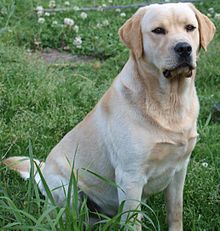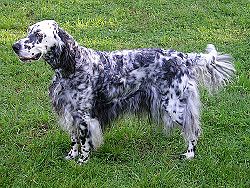The Sporting Group Dog
common training and behavior problems
Sporting Group breeds were developed to work closely with people hunting birds and small game. You will typically find pointers, retrievers, setters, and spaniels in this group. There are four major breeds in the non-sporting group, with several breeds belonging to each type:
Bred to work, dogs in the sporting group need physical and mental stimulation. Owners of dogs in the sporting group will call us with a variety of issues, the most common are:
- Excessive engergy
- Digging
- Chasing animals
- Mouthing and chewing
- Aggression
- Excessive attention seeking
- Pulling on the leash
- Dominance issues
- Separation anxiety
- General obedience
For recommended reading on dog behavior, view our listmania list at amazon.com.
![]()
sporting group dogs
One of the oldest meanings for the word sport in English is hunting as an entertainment for members of the nobility and elite classes.[1] To assist in the hunting of birds and small game, various sporting types of dogs were developed, which became the ancestors of today's pointer, retriever, setter, and spaniel purebred dog breeds. Because they were developed as bird dogs with energetic hunting abilities in water and field settings, most sporting dogs require regular exercise. Their naturally active and alert demeanor also makes them likeable and well-rounded companions.
the pointer
 A pointing breed is a type of gundog typically used in finding game. Gundogs are traditionally divided into three classes: retrievers, flushing dogs, and pointing breeds. The name pointer comes from the dog's instinct to point, by stopping and aiming its muzzle towards game. This demonstrates to the hunter the location of his or her quarry and allows them to move into gun range. Pointers were selectively bred for dogs who had abundant pointing and backing instinct. They typically start to acquire their hunting instincts at about 2 months of age.
The pointing breeds can be dated to England and Europe in about the 1650s.[1] They may have descended from dogs from Spain. (Furgus, 2002) Pointing dogs were originally used by hunters who netted the game. The dog would freeze or set (as in Setter) and allow the hunter to throw the net over the game before it flushed. Flushing dogs, on the other hand, were often used by falconers to flush game for the raptors.
A pointing breed is a type of gundog typically used in finding game. Gundogs are traditionally divided into three classes: retrievers, flushing dogs, and pointing breeds. The name pointer comes from the dog's instinct to point, by stopping and aiming its muzzle towards game. This demonstrates to the hunter the location of his or her quarry and allows them to move into gun range. Pointers were selectively bred for dogs who had abundant pointing and backing instinct. They typically start to acquire their hunting instincts at about 2 months of age.
The pointing breeds can be dated to England and Europe in about the 1650s.[1] They may have descended from dogs from Spain. (Furgus, 2002) Pointing dogs were originally used by hunters who netted the game. The dog would freeze or set (as in Setter) and allow the hunter to throw the net over the game before it flushed. Flushing dogs, on the other hand, were often used by falconers to flush game for the raptors.Most continental European pointing breeds are classified as versatile gun dog breeds or sometimes HPR breeds (for hunt, point and retrieve). The distinction is made because versatile breeds were developed to find and point game as all pointing breeds, but were also bred to perform other hunting tasks as well. This distinction likely arose because while the British developed breeds which specialized in tasks such as pointing, flushing and retrieving from land or water, in Continental Europe, the same dog was trained to be able to perform each of these tasks (albeit less effectively). The North American Versatile Hunting Dog Association defines versatility as "the dog that is bred and trained to dependably hunt and point game, to retrieve on both land and water, and to track wounded game on both land and water." As an example, German Shorthair Pointers are often used to retrieve birds duck hunting whereas, calling upon a Pointer to do the same would be less common. Unlike the pure pointing and setting breeds, many versatile dogs were bred for working in dense cover, and traditionally have docked tails.
Wikipedia contributors. "Pointing breed." Wikipedia, The Free Encyclopedia. Wikipedia, The Free Encyclopedia, 19 Sep. 2012. Web. 29 Sep. 2012.
the retriever
 A retriever is a type of gun dog that retrieves game for a hunter. Generally gun-dogs are divided into three major classifications: retrievers, flushing spaniels, and pointing breeds. Retrievers were bred primarily to retrieve birds or other prey and return them to the hunter without damage. Although spaniels and some pointing breeds routinely retrieve game, and many retrievers are skilled in finding game, retrievers are distinguished in that non-slip retrieval is their primary function. As a result, retriever breeds are bred for soft mouths and a great willingness to please, learn, and obey. A soft mouth refers to the willingness of the dog to carry game in its mouth without biting into it. "Hard mouth" is a serious fault in a hunting dog and is one that is very difficult to correct. A hard-mouthed dog renders game unpresentable or at worst inedible.
A retriever is a type of gun dog that retrieves game for a hunter. Generally gun-dogs are divided into three major classifications: retrievers, flushing spaniels, and pointing breeds. Retrievers were bred primarily to retrieve birds or other prey and return them to the hunter without damage. Although spaniels and some pointing breeds routinely retrieve game, and many retrievers are skilled in finding game, retrievers are distinguished in that non-slip retrieval is their primary function. As a result, retriever breeds are bred for soft mouths and a great willingness to please, learn, and obey. A soft mouth refers to the willingness of the dog to carry game in its mouth without biting into it. "Hard mouth" is a serious fault in a hunting dog and is one that is very difficult to correct. A hard-mouthed dog renders game unpresentable or at worst inedible.The retriever's willingness to please and trainability have made retrievers such as the Labrador Retriever and Golden Retriever popular as assistance dogs.
Although most individual retrievers have the raw capacity to be trained to perform as a gun dog, a significant amount of thought and effort is given to breeding in specific desired traits into dogs from field bred lines that greatly enhance the training process. When breeding retrievers for field work extensive consideration is given to:
- Biddableness. Because producing a well trained retriever capable of performing the tasks outlined above requires a significant amount of time and effort a retriever that is intelligent, controllable and open to learning (biddable) is of utmost importance.
- Desire & Drive. This trait(s) covers a broad range of behaviors exhibited by the “good retriever”. Most notably they will demonstrate the desire to retrieve almost to the point of manic behavior and will take on significant obstacles to make a retrieve. They will also demonstrate an exceptional interest in birds, bird feathers and bird scent which is termed “birdiness”.
- Marking and Memory. Eyesight and depth perception are of paramount importance to a dog's ability to mark downed game. Remembering each fall is also critical. While there are special techniques that retriever trainers use to help a dog to mark and remember downed game a good retriever is born with these “raw tools”.
- Nose. Dogs are led primarily by their nose. A good retriever will use its nose to find downed game in heavy cover and will use it while quartering a field to locate and flush upland game birds.
- Soft-mouth. A soft-mouthed dog is needed to ensure that retrieved game is fit for the table. A soft mouthed dog will pick up and hold game softly but firmly on the retrieve. Dogs that unnecessarily drop birds, crunch on, chew or even eat the bird before delivery to the handler are considered “hard-mouthed” or are described as having “mouth problems”. While training can overcome most “mouth problems” a dog with an inherently soft-mouth is more desirable when starting the training process.
- Hardiness. Waterfowl hunting is a cold weather sport that is undertaken across a wide variety of locations and conditions from thick flooded timber in the south US, to icy and ice covered ponds in the mid-west to frigid seas along upper the New England coast. A good retriever will willingly re-enter the water and make multiple retrieves under these and other extreme conditions. Wikipedia contributors. "Retriever." Wikipedia, The Free Encyclopedia. Wikipedia, The Free Encyclopedia, 29 Sep. 2012. Web. 29 Sep. 2012.
the setter
 The setter is a type of gundog used most often for hunting game such as quail, pheasant, and grouse. A setter silently searches for game by scent. When prey is encountered the dog freezes rather than chasing after the game. Setters get their name from their distinctive stance; a sort of crouch or "set" upon finding their quarry. Most setters are born with a natural proclivity to hunting. Dogs which show excitement and interest in birds are described as being "birdy", and trainers look for puppies that show this particular trait. Training is usually done with domesticated pigeons.
The setter is a type of gundog used most often for hunting game such as quail, pheasant, and grouse. A setter silently searches for game by scent. When prey is encountered the dog freezes rather than chasing after the game. Setters get their name from their distinctive stance; a sort of crouch or "set" upon finding their quarry. Most setters are born with a natural proclivity to hunting. Dogs which show excitement and interest in birds are described as being "birdy", and trainers look for puppies that show this particular trait. Training is usually done with domesticated pigeons.The ancestors of modern setters probably originated in Spain in the 16th century and evolved from spaniels. Later these dogs were exported to France and England where the breeds were developed into today's varieties.
Most setter breeds have long smooth, silky coats that require maintenance. Setters have a tendency to be happy, playful dogs and are usually very friendly both to people and other dogs. They have a great deal of energy and require daily exercise.
the spaniel
 A spaniel is a type of gun dog. It is assumed spaniels originated from Spain as the word spaniel may be derived from Hispania (the Iberian Peninsula) or possibly from the French phrase "Chiens de l’Espagnol" (Dogs of the Spaniard). Spaniels were especially bred to flush game out of dense brush. By the late 17th century spaniels had become specialized into water and land breeds. The extinct English Water Spaniel was used to retrieve water fowl shot down with arrows. Land spaniels were setting spaniels—those that crept forward and pointed their game, allowing hunters to ensnare them with nets, and springing spaniels—those that sprang pheasants and partridges for hunting with falcons, and rabbits for hunting with greyhounds. During the 17th century, the role of the spaniel dramatically changed as Englishmen began hunting with flintlocks for wing shooting. Charles Goodall and Julia Gasow (1984) write the spaniels were "transformed from untrained, wild beaters, to smooth, polished gun dogs."
A spaniel is a type of gun dog. It is assumed spaniels originated from Spain as the word spaniel may be derived from Hispania (the Iberian Peninsula) or possibly from the French phrase "Chiens de l’Espagnol" (Dogs of the Spaniard). Spaniels were especially bred to flush game out of dense brush. By the late 17th century spaniels had become specialized into water and land breeds. The extinct English Water Spaniel was used to retrieve water fowl shot down with arrows. Land spaniels were setting spaniels—those that crept forward and pointed their game, allowing hunters to ensnare them with nets, and springing spaniels—those that sprang pheasants and partridges for hunting with falcons, and rabbits for hunting with greyhounds. During the 17th century, the role of the spaniel dramatically changed as Englishmen began hunting with flintlocks for wing shooting. Charles Goodall and Julia Gasow (1984) write the spaniels were "transformed from untrained, wild beaters, to smooth, polished gun dogs."In assisting hunters, it is desirable that Spaniels work within gun range, are steady to shot, are able to mark the fall and retrieve shot game to hand with a soft mouth. A good nose is highly valued, as it is in most gun dog breeds. They are versatile hunters traditionally being used for upland game birds, but are equally adept at hunting rabbit and waterfowl. Whether hunting in open fields, woodlands, farm lands—in briars, along fencerows or marshlands, a spaniel can get the job done.
Breed Specific Behavior
We encourage the potential dog owner to fully investigate individual breed and bloodline characteristics before acquiring a new dog. We will continue to add to and update this section over time.

